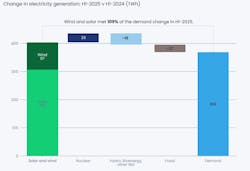Report: Fossil Fuel Use Declines as Renewables Overtake Coal for the First Time
Solar and wind generation expanded faster than global electricity demand in the first half of 2025, leading to a slight decline in both coal and gas use compared to the same period last year, according to new analysis from Ember. The report finds that record solar growth and steady wind expansion are reshaping the global power mix, with renewables overtaking coal for the first time on record.
“We are seeing the first signs of a crucial turning point,” said Małgorzata Wiatros-Motyka, senior electricity analyst at Ember. “Solar and wind are now growing fast enough to meet the world’s growing appetite for electricity. This marks the beginning of a shift where clean power is keeping pace with demand growth.”
Global electricity demand rose 2.6% in the first half of 2025, adding 369 TWh compared to the same period last year. Solar generation met 83% of that increase, growing by 31% year-over-year (up 306 TWh).
Combined solar and wind growth was sufficient not only to meet the rise in demand but also to begin displacing fossil generation. Coal generation fell by 0.6% (-31 TWh) and gas by 0.2% (-6 TWh), partly offset by a small increase in other fossil sources, for a total decline of 0.3% (-27 TWh). As a result, global power sector emissions fell by 0.2%.
For the first time on record, renewables generated more electricity than coal. Renewable generation reached 5,072 TWh globally in the first half of 2025, up from 4,709 TWh in the same period of 2024. Coal generation declined to 4,896 TWh, down 31 TWh year-on-year.
The modest 0.3% drop in fossil generation marks a significant milestone, indicating that solar and wind growth can now, in some circumstances, fully meet increases in electricity demand. Ember’s analysis suggests this trend will extend over longer periods as renewable capacity continues to expand.
Among the world’s largest economies, China and India recorded declines in fossil generation, while the U.S. and the European Union saw increases.
China’s fossil generation fell 2% (-58.7 TWh) as it added more solar and wind capacity than the rest of the world combined. India’s clean energy growth was more than three times higher than its electricity demand growth, which slowed to 1.3% (+12 TWh) from 9% (+75 TWh) a year earlier. Lower demand and record renewable expansion drove down fossil generation in India, with coal falling 3.1% (-22 TWh) and gas 34% (-7.1 TWh).
In contrast, fossil generation rose in the U.S. as demand growth exceeded clean power additions, and in the EU as weaker wind and hydro output led to higher gas and coal generation.
Ember’s analysis concludes that with half the world already past the peak of fossil generation, clean energy growth is now capable of keeping pace with rising electricity demand—though progress varies widely between regions.

